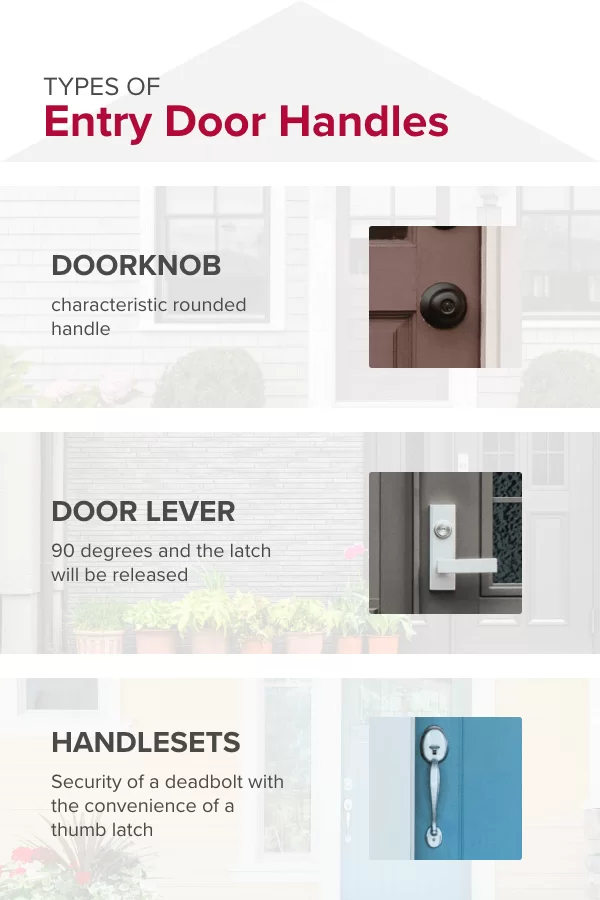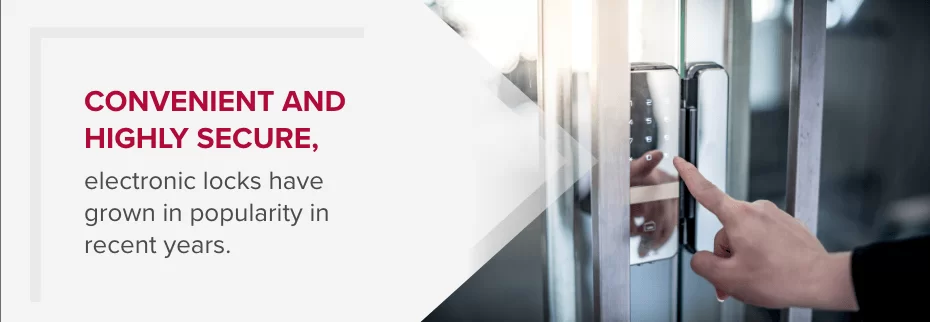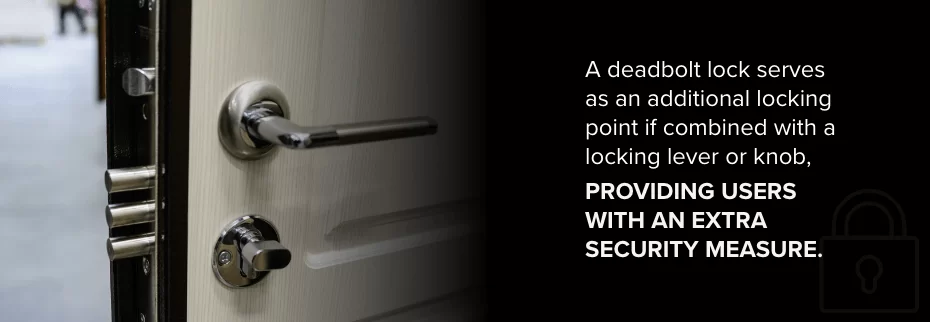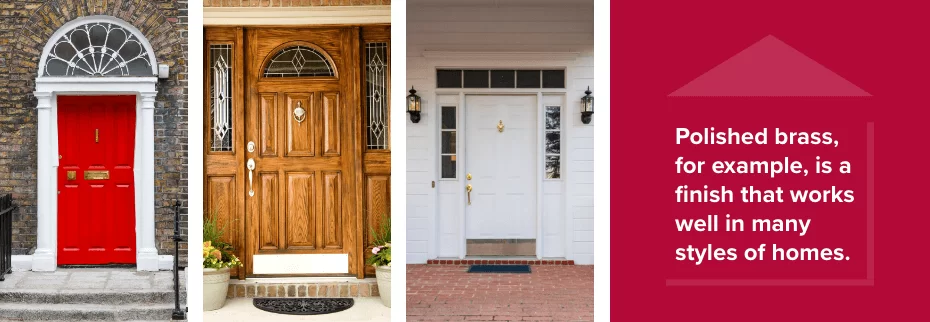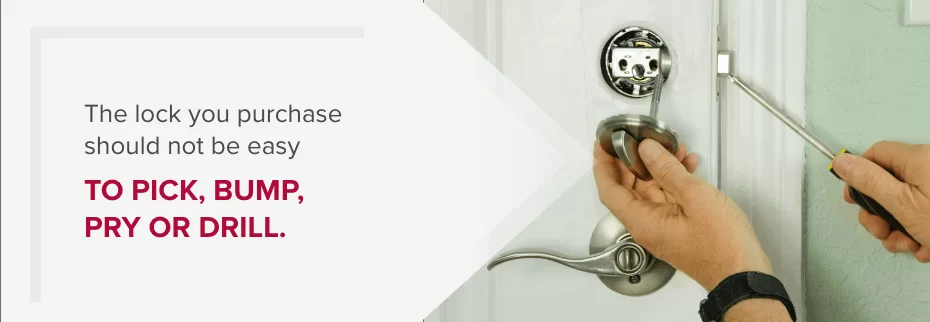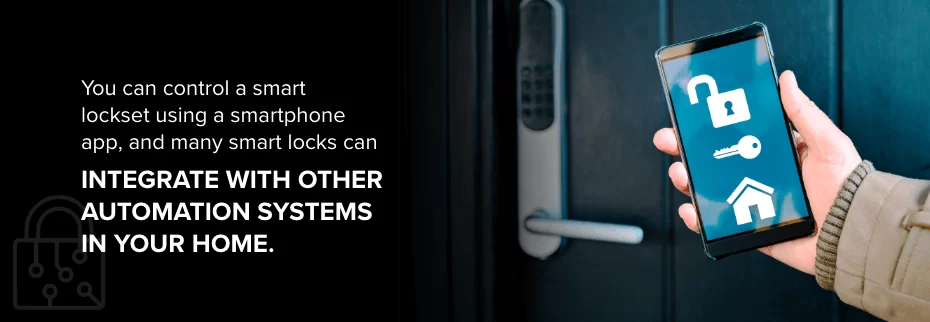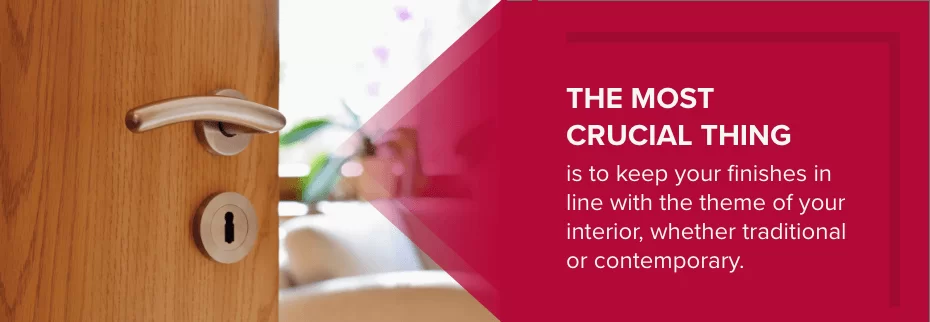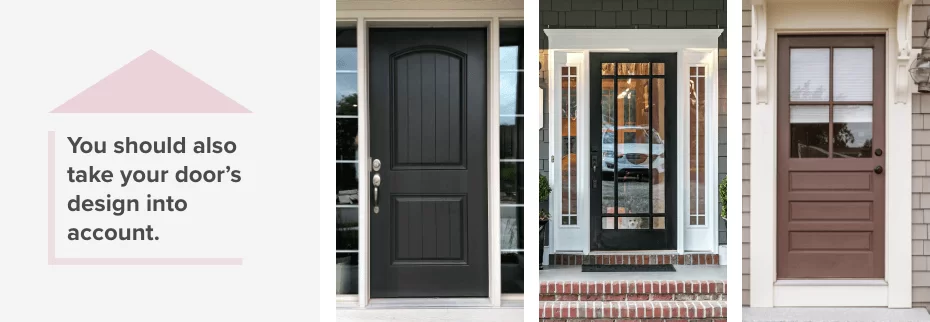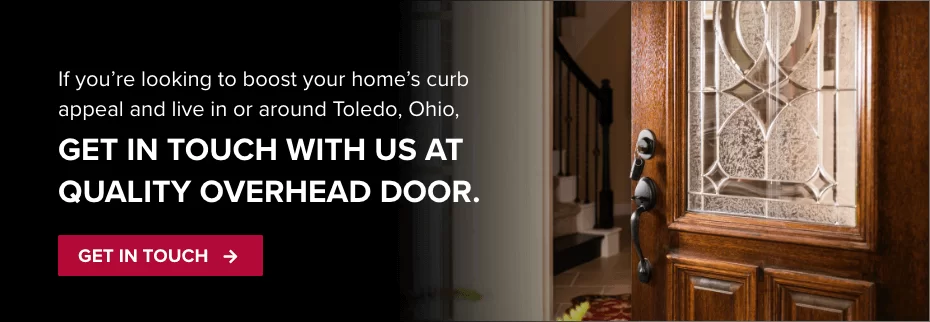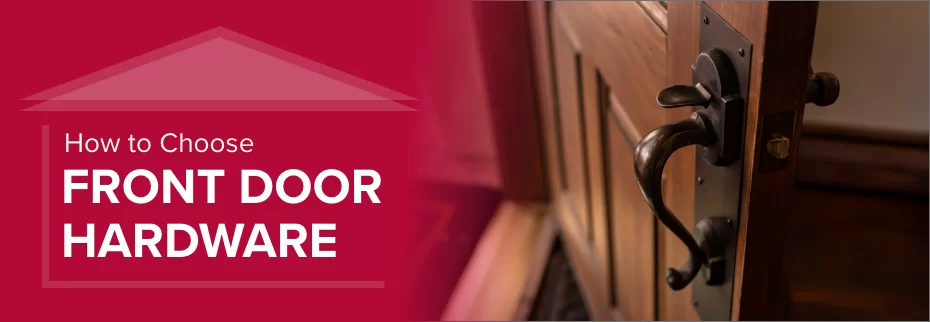
Both functional and stylish, front door hardware can be highly customized to meet your needs and tastes. In this comprehensive guide, we’ll cover the different types of front door handles, locks and finishes available and share some tips on how to choose hardware for your front door.
Types of Entry Door Hardware
Knowing how to pick a front door handle involves various considerations — you have to decide how you want to open the door and lock it as well as the material and finish of your hardware. We’ll start by discussing the different types of entry door handles:
Types of Entry Door Handles
There is a wide variety of front door handle options, but the most popular ones are knobs, levers and handlesets. Understand the differences to help you choose entry door hardware:
- Doorknobs: Doorknobs, in their most classic form, feature a characteristic rounded handle. When turned, this releases a latch between the door jamb and door. A keyed entry door can be easily installed, and you can pair it with a deadbolt or, if you want an even more secure entry, an electronic lock.
- Door levers: Operating a door lever is easy — just turn it 90 degrees and the latch will be released. For those who have trouble turning or gripping a doorknob, a door lever is often a better option. Some door levers include number locks, which prevent latch release and should be paired with a deadbolt lock for additional security.
- Handlesets: A keyed entry handleset combines the security of a deadbolt with the convenience of a thumb latch, which is pressure sensitive. They are available as a single-piece handleset, in which the pull handle, latch and deadbolt are located on one decorative panel. Other handleset types feature separate lock trims, where just one end of the latch handle is on the panel with the deadbolt.
Types of Locksets
When it comes to ways to lock your door, you have a number of options ranging from traditional keyed deadbolts to modern electronic door locks. Explore some of the most popular choices below.
1. Electronic Door Locks
Convenient and highly secure, electronic locks have grown in popularity in recent years. They don’t rely on a key to be opened but instead feature a touch screen, keychain remote or numeric keypad. You can also find one with a biometric lock, which reads your thumbprint. There are even electronic locks that detect when a key fob or registered smartphone is nearby and will unlock when touched.
Electronic lock models usually come with keys that can be used for backup and often offer automatic, no-touch locking once a certain time period has passed. We recommend looking for a lock that allows you to make temporary access codes that service providers and guests can use, as well.
There are also electronic locks that connect to home automation or home security systems. These are sometimes referred to as connected locks and are even more functional and convenient. Depending on the system and hardware you have, you can:
- Lock your door automatically when your security system is on.
- Turn off your security system when unlocking a door.
- Operate locks remotely from your computer or other devices.
- Receive a text notification when someone goes in your house.
- Receive alerts if someone tries to tamper with your lock or tries to enter forcefully.
2. Keyed Doorknobs
Doorknobs, which are among the most popular types of key entry hardware, offer traditional operation and design. When you turn a keyed doorknob, it disengages a latch. When the doorknob is locked, you cannot disengage the latch from outside unless you have a key. The inside knob features a thumb turn, which is used to lock or unlock the door. You can also find models that can be locked on the inside with the push of a button and unlocked when the knob is turned.
3. Keyed Door Levers
A door lever is designed to be operated easily and doesn’t need to be grasped and twisted like a knob. Just push down the lever to disengage the latch. Like with knobs, when you lock the level, the latch cannot be disengaged from outside without using a key. The lever’s inside portion features a push-button or thumb turn that enables users to engage the lock. You may come across models that disengage the lock when the inside lever is manipulated, which makes exiting easier.
A door lever can be right-handed, left-handed or universal. To figure out which type you require, look at your door from outside the house. If the door has hinges located on the left, the lever you get should be left-handed or universal. Likewise, if it has hinges on the right, get a model that’s right-handed or universal.
4. Keyed Deadbolts
A deadbolt lock serves as an additional locking point if combined with a locking lever or knob, providing users with an extra security measure. Some lever and knob sets come with deadbolts, and there are two kinds:
- Single-cylinder: A single-cylinder deadbolt requires a key when unlocking from outside but from the inside, they can be unlocked with a thumb turn or knob. This style is a good choice for doors without any glass that an intruder can break and operate the knob from outside. The single-cylinder deadbolt design lets you unlock your door and leave your house faster if there is an emergency because you won’t need to find your key.
- Double-cylinder: A double-cylinder deadbolt can only be unlocked with a key — both from the outside and inside, which improves security if your door has glass close to the lock. Note that unlocking a door with a double-cylinder deadbolt can take a little longer, and some buildings in some areas prohibit them. If your door has a double-cylinder deadbolt, we recommend keeping a key in a designated place so you can access it easily if there is an emergency.
5. Keyed Handlesets
Adding a decorative, bold touch to your door, keyed handlesets feature an exterior handle, a latch operated with your thumb and a matching deadbolt. To operate the latch from inside, there is a lever or knob. These handlesets come with either left-handed, right-handed or universal levers. Depending on your model, the deadbolt is sometimes single-cylinder and other times double-cylinder.
Keyed handlesets are also found on double doors, where some manufacturers offer nonfunctional, matching handlesets to complement the functional hardware. If you’re looking to replace a handleset, we recommend looking for an adjustable model that allows the door’s existing installation holes to be used.
Types of Hardware Finishes
In addition to the style and lockset type, you will also want to think about what hardware finish you want. Door hardware is available in a wide variety of finishes, making it easy to find the perfect one to match your home’s decor.
Polished brass, for example, is a finish that works well in many styles of homes. If you’d like to go for an antique look, consider a brass or pewter finish, and if you want a contemporary appearance, check out some brushed metal options. Keep in mind that a finish may be designed to change its appearance with time and use.
To match the finish of your door hardware with other types of hardware in your home, such as electrical fixtures on your porch or in your entryway, think about purchasing the same brand. With the wide variety of door hardware finishes available, you can also shop around with different brands to find what you’re looking for.
Below are some popular finish options you’re likely to come across while shopping:
- Bronze: Oil-rubbed and antique bronze doorknobs may change color with time. The more you touch the knob, the more the color under the brown veneer will be visible.
- Nickel: Brushed or satin nickel features a textured and silver-colored appearance.
- Chrome: Chrome, when polished, looks traditional but is also sleek enough to be used in modern and contemporary interiors.
- Black: This sophisticated, fashionable option is great for minimalistic, modern and other similar decors.
- Pewter: Pewter finish is available in both flat and antique options and offers a rustic silver- or gray-colored appearance.
- Brass: If you’re planning to use a brass knob, lever or handleset on an outside door, find a polished brass finish that is designed for use outdoors. This option will prevent the brass from tarnishing and looks good with both traditional and contemporary designs.
- Copper: Stylish and elegant copper handles are thought to possess antimicrobial properties, meaning they could help prevent some microorganisms from spreading. Note that copper door handles can patina over time, turning a green or aqua shade.
- Stainless steel: This silver-colored finish is another great choice for exterior use, as it won’t rust.
- Zinc: A zinc alloy door handle is exceptionally durable and won’t rust. You’ll find zinc alloy door handles in an array of color options.
- Etched, faceted or clear finishes: These options will provide your living space with interesting extra decoration.
- Custom doorknobs: If you’d like unique accents, look into custom doorknobs.
How to Determine the Best Entry Door Hardware
Now that you know the most common types of handles, locksets and finishes, we’re going to help you figure out which one would work best for your home. Keep these following valuable tips in mind to determine front door hardware for your home:
- Know the thickness of your door: When shopping, make sure the hardware you’re considering is compatible with your door’s thickness. The standard thickness for exterior doors is 1 3/4 inches, whereas interior doors have a standard thickness of 1 3/8 inches.
- Pay attention to borehole size: When looking at hardware, look at its required borehole size. Replacement hardware will need to fit your door, and hardware for a new door will require a correctly sized hole saw. Generally, a deadbolt requires a borehole with a 1 1/2-inch or 2 1/8-inch diameter. Handlesets and levers generally require a hole diameter of 2 1/8 inches.
- Look at the needed backset for replacement hardware: The backset refers to the distance from the borehole’s center to the door’s edge. You’ll commonly find 2 3/4 inches and 2 3/8 inches for the backset, although some models are able to fit several backsets. Ensure the model you pick will fit your door.
- Make a note of the configuration of the bolt or latch: Square-corner and round-corner configurations feature a plate that surrounds the bolt or latch on the door’s edge. Hardware featuring a drive-in configuration doesn’t have a plate. Buying a replacement lockset with the same configuration as your old one will make installation much simpler. There are also models that work with many configurations.
- Be sure your hardware is suitable for your application: Entry hardware makes exterior doors more secure. Privacy hardware features a simple lock and is meant for bedroom and bathroom doors. Passage hardware is meant for interior doors requiring no locks, such as family room and closet doors. Dummy hardware exists for decoration and merely serves to match operational hardware on double doors. It can also serve as lever or knob pulls on interior doors not needing functional hardware. Be sure to only shop exterior options for entry doors for the most durability and security.
- Check the level of security for entry door locks: When shopping for entry door locks, see what its security grade is. The American National Standards Institute (ANSI) has designated three levels measuring security — with grade one providing the highest level of security and grade three providing a basic level of security.
- Try to have all the locks in your home be the same brand: Generally, you can have more than one entry door in your home set keyed to open with one key. If the locks are different brands, this may not be possible. Some locks offer do-it-yourself rekeying, which lets you configure your lock without having to take the hardware out from your door. This feature is helpful if a key has gone missing and you want to make sure no one can use it to enter your home.
- Try to find a lock that cannot be easily defeated: The lock you purchase should not be easy to pick, bump, pry or drill.
Tips for Selecting a Lockset
When shopping for a lockset, one of the first decisions you’ll have to make is whether you want a keyed lockset, electronic lockset or a smart lock. When deciding, ask yourself these questions:
- Do you get locked out frequently? If you or another member of your household tends to misplace keys, you may want to consider a keyless lockset with an access code you can program. You’ll avoid having to call a locksmith, which can be pricey.
- Do you often have to grant others access to your home? Smart locks and electronic locks sometimes let you make temporary access codes, which guests and maintenance professionals can use to enter your home remotely. You won’t ever have to hide an extra key outside, which burglars often look for.
- What design requirements do you have? If you’re hoping for a more cohesive look, keep in mind that traditional keyed locks tend to come in more finish and style options. Standard styles will let you more easily match the look of your existing hardware.
- Do you want a smart home platform? You can control a smart lockset using a smartphone app, and many smart locks can integrate with other automation systems in your home.
- How much are you willing to spend? Generally speaking, keyed locks are not as expensive as their high-tech electronic counterparts.
Tips for Selecting a Finish
From chrome to black matte, there is a large number of door hardware finishes to choose from. To decide what color hardware to choose for the front door, consider these pointers:
1. Choose a Finish That Coordinates Well With Your Home
When selecting a finish for your front door’s hardware, the most important consideration is whether it goes well with your home’s overall design. While hardware with a polished chrome or bronze finish might look great when you buy it in the store, it may not complement other elements in your home. But with the great number of finishes available, you’ll have no trouble finding a finish without having to rethink your home’s interior design.
To make the best choice, consider the rest of your home’s design elements and coordinate the exterior and interior handle or doorknob finish with those distinctive elements. Keep it simple, too. From traditional and contemporary to industrial or rustic, there are lots of finishes out there you can use to mesh well with your home’s architectural appeal and design theme.
2. Consider Your Door’s Function
When picking out handles and doorknobs, think about the functions you’d like that door to serve. Examples of common door functions include passage, privacy and keyed entry.
The finish you select for your entry door hardware is among the first things your guests see. For privacy and passage doors, matching the finish with that of your entry door hardware will complement the overall style of your home. That doesn’t mean you can’t pick a finish with colorful or bold elements, which can add unique style to your home. The most crucial thing is to keep your finishes in line with the theme of your interior, whether traditional or contemporary.
3. Remember Aesthetic Appeal
While style and design are key when it comes to door hardware, aesthetic appeal is also essential. You don’t want to pick a doorknob finish unless you love it. If you’re into fashionable hardware with a modern appearance, consider matte black for your knobs, handlesets, deadbolts, levers and other accessories.
From bronze to black to satin nickel or antique brass, every finish has an aesthetic appeal that goes well with certain styles. Think about whether aesthetics are important to you and, if there are, make a well-thought-out decision while remembering the style, functionality and design of your handles and doorknobs.
4. Consider the Existing Door and Accessories in Your Home
‘
Whether you’re getting new accessories for your doors like push plates and latches or just replacing functional accessories such as strike plates and hinges, you have to decide on their finishes. So, when picking out a finish for your doorknob, think about what finishes are on your existing door hardware. If there is a satin nickel finish for door hinges, buying handles or doorknobs with that same finish will complete that look.
You should also take your door’s design into account when selecting from different types of front door handles and hardware. Sleek and contemporary designs might suit hardware with straight lines and modern metallics. Rustic doors with decorative finishes will suit equally decorative hardware and classic finishes.
Check out Our Wide Selection of High-Quality Entry Doors
Want to go beyond choosing a handle for your front door? An attractive new entry door can transform the appearance of your home’s exterior. In addition to its aesthetic qualities, a new front door will also improve your home’s security and energy efficiency. Browse the front door options available at Quality Overhead Door, where you can choose from many designs, sizes and colors.
At Quality Overhead Door, we have a helpful team of experienced technicians who can help you pick the best entry door for your home. If you’re looking to boost your home’s curb appeal and live in or around Toledo, Ohio, get in touch with us at Quality Overhead Door. Or visit our showroom to see our entry doors on display.
Additional Resources on Entry Doors:
- Small Home Improvements Pack a Big Punch
- How Fiberglass vs Wood Front Doors
- How What is the Best Material for a Front Door
- What are the Parts of a Front Door

